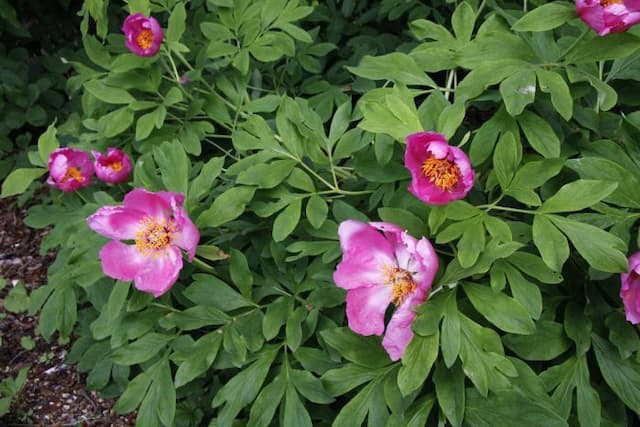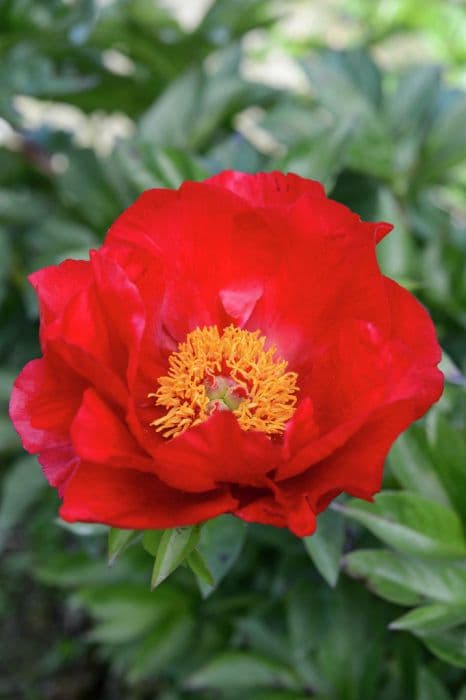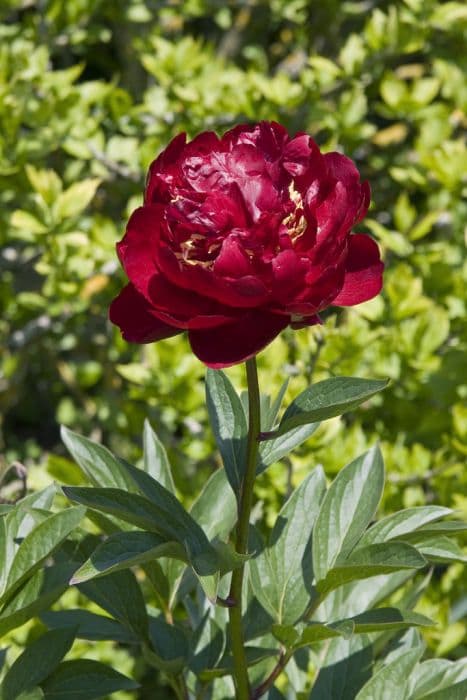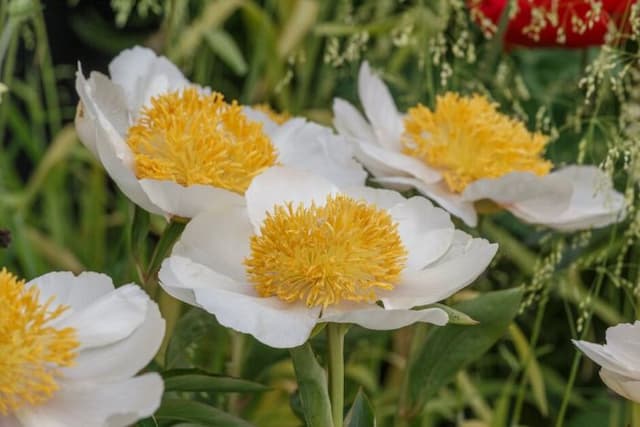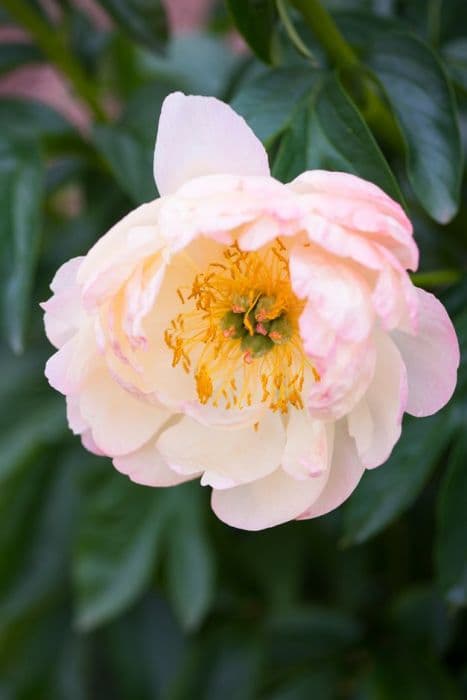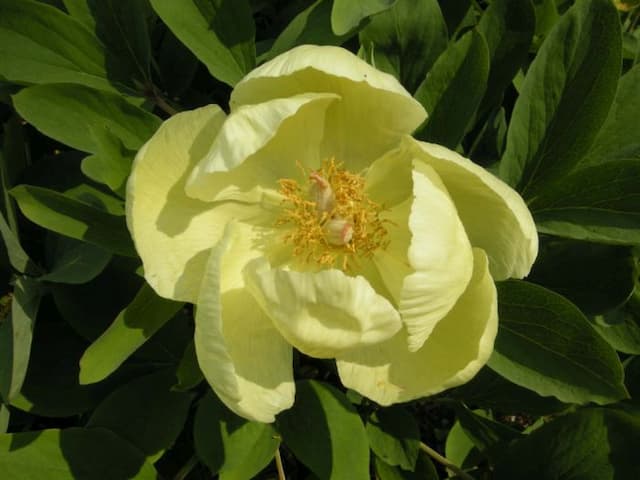Chinese peony Paeonia lactiflora 'Duchesse de Nemours'

ABOUT
The plant commonly known as 'Duchesse de Nemours' peony is an exquisite perennial that boasts a luxurious display of blooms. This variety is particularly known for its large, double flowers that are creamy white in color and often possess a hint of ivory or pale yellow at the base of the petals. These lush blooms exude a delightful, sweet fragrance, and they are accented with a halo of contrasting bright yellow stamens at their center. The flowers have a full, globular shape, resembling the poofiness of a ball gown, which adds to their regal and sophisticated look. The foliage of the 'Duchesse de Nemours' peony is deep green and has a glossy texture. The leaves are divided and have a lance-like shape, providing a dense, lush backdrop for the spectacular blooms. The overall shape of the plant is a bushy mound, which serves as a perfect setting for the flowers to stand out when they make their annual debut in late spring or early summer. This plant is prized for its ornamental value in the garden. Its elegant blooms are often used in floral arrangements and are favored for special occasions, like weddings, due to their classic beauty and fragrance. Despite the absence of specifics regarding the plant's size, the 'Duchesse de Nemours' peony is noted for making a significant visual impact in the landscape where it can thrive and flourish.
About this plant
 Names
NamesSynonyms
Chinese Peony, White Peony, Duchesse de Nemours Peony.
Common names
Paeonia lactiflora 'Duchesse de Nemours'.
 Toxicity
ToxicityTo humans
Peony, commonly known by this name, is not considered highly toxic to humans. However, parts of the peony plant contain compounds that may cause stomach upset if ingested in large quantities. The symptoms of peony poisoning are typically mild and can include nausea, vomiting, and diarrhea. Ingesting any part of the peony should be avoided to prevent these potential negative effects.
To pets
Peony is considered to be mildly toxic to pets, such as dogs and cats. If ingested, the plant can cause gastrointestinal irritation and discomfort. Symptoms of peony poisoning in pets may include vomiting, diarrhea, and drooling. It's important to keep pets from chewing on or ingesting peonies to evade these possible consequences.
 Characteristics
CharacteristicsLife cycle
Perennials
Foliage type
Deciduous
Color of leaves
Green
Flower color
White
Height
2-3 feet (60-90 cm)
Spread
2-3 feet (60-90 cm)
Plant type
Herbaceous
Hardiness zones
3-8
Native area
Asia
Benefits
 General Benefits
General Benefits- Ornamental Appeal: This variety of peony is known for its large, fragrant, double white blooms that add aesthetic value to gardens.
- Landscape Versatility: Can be used in borders, as a specimen plant, or in mass plantings for visual impact.
- Seasonal Interest: Offers a display of lush green foliage after flowering, extending its visual interest beyond the blooming period.
- Attracts Pollinators: The flowers are attractive to bees and butterflies, supporting local ecosystems.
- Longevity: Peonies are long-lived perennials that can thrive for decades with proper care.
- Cut Flower Use: The blooms are ideal for cutting and arranging in floral displays, with a long vase life.
- Low Maintenance: Once established, they require minimal care, making them suitable for gardeners of all skill levels.
- Cold Hardy: They are capable of withstanding cold winters, making them suitable for a variety of climates.
 Medical Properties
Medical Properties- Anti-inflammatory: Paeonia lactiflora has been traditionally used to reduce inflammation.
- Analgesic: It may possess pain-relieving properties.
- Immunomodulatory: The plant could have effects on the immune system, potentially moderating its activity.
- Antioxidant: Paeonia lactiflora may contain compounds that help in protecting the body from oxidative stress.
 Air-purifying Qualities
Air-purifying QualitiesThis plant is not specifically known for air purifying qualities.
 Other Uses
Other Uses- Paeonia lactiflora 'Duchesse de Nemours', commonly known as peony, can be used in the production of perfumes due to its fragrant blooms.
- The flowers can be crystallized and used as edible decorations for desserts and cakes, adding both beauty and a slight floral taste.
- Peony petals can be used in making natural dyes for fabrics, giving a soft, creamy hue to the material.
- Dried peony petals can serve as a component for potpourri, contributing their pleasant aroma to the mix.
- The peony is often used in photography and art classes as a subject for students to practice capturing the complexity and beauty of nature.
- Peony flowers can be used in the hospitality industry to create a welcoming and luxurious atmosphere in hotel lobbies and upscale bathrooms.
- In cultural festivals or events, peonies are used in floral displays and arrangements to signify prosperity and honor tradition.
- In some areas, peony petals are scattered on the paths of wedding ceremonies as a symbol of good fortune and a happy marriage.
- During spring festivals, the peony is often a centerpiece in parades and floral exhibitions, showcasing the beginning of the growing season.
- They are occasionally used in crafting, where the petals are incorporated into handmade paper or used to create botanical jewelry such as resin pendants.
Interesting Facts
 Feng Shui
Feng ShuiPeony is often used in Feng Shui as a symbol of love, prosperity, and good fortune, particularly when placed in the southwest sector of a garden or home to enhance relationship and romance luck.
 Zodiac Sign Compitability
Zodiac Sign CompitabilityThe Peony is not used in astrology practice.
 Plant Symbolism
Plant Symbolism- Prosperity: The lush, full blooms of the peony are often associated with abundance and good fortune, making it a symbol of prosperity.
- Romance: With its large, soft petals and sweet fragrance, the peony is seen as a romantic flower, representing love and affection.
- Honor and Nobility: The peony has a noble bearing and is frequently associated with honor and high social status, particularly in Asian cultures.
- Beauty: Its aesthetically pleasing appearance makes the peony a symbol of beauty in both physical and spiritual forms.
- Wealth: Due to its association with prosperity, peonies are also seen as symbols of wealth and success, especially in business.
- Good Luck: Peonies are believed to bring good luck and positive outcomes, often used in festive occasions for this reason.
- Compassion: Some cultures see the peony as a token of compassion and bashfulness, due to the flower's gentle appearance.
- Happy Marriage: Being considered a harbinger of good fortune and a happy relationship, the peony is a common gift for newlyweds or as a wedding decoration.
 Water
WaterFor the common peony (Paeonia lactiflora 'Duchesse de Nemours'), watering should be thorough, allowing the soil to become moist but not soggy. During the growing season, peonies typically need about 1 inch of water per week, whether from rainfall or manual watering. If there isn't enough rain, use a drip irrigation system or a soaker hose to apply the water directly to the base of the plant to avoid wetting the foliage. In the absence of rainfall, water the peony with about 0.5 to 1 gallons of water weekly, monitoring the soil moisture to adjust as needed. It's crucial to reduce watering after the bloom period and as the plant enters dormancy in the fall.
 Light
LightPeonies, including 'Duchesse de Nemours', thrive best in full sun, receiving at least six hours of direct sunlight daily. An optimal location is one where the plant can bask in the morning sun, as this helps to dry dew from the leaves, reducing the risk of fungal diseases. Partial shade is acceptable, especially in regions with very hot summers, but too much shade can reduce the abundance of blooms.
 Temperature
TemperaturePeonies like 'Duchesse de Nemours' are hardy and can tolerate a wide temperature range, typically from USDA hardiness zones 3 through 8. They can survive winter temperatures as low as -40°F and summer temperatures reaching above 90°F. However, for optimal growth and flowering, they prefer spring and summer temperatures ranging between 65°F and 75°F. Sufficient cold temperatures in winter are actually beneficial, as peonies require a period of winter chill to set buds.
 Pruning
PruningPruning peonies like 'Duchesse de Nemours' is important for their overall health and to encourage vigorous growth. Cut back the foliage to the ground in late fall after the first frost has killed the leaves, which helps prevent overwintering diseases. During the growing season, remove spent flower heads to tidy the plant and potentially encourage additional blooms. Peonies rarely require pruning of live tissues except for the removal of damaged or diseased stems, which can be done as needed throughout the growing season.
 Cleaning
CleaningAs needed
 Soil
SoilThe best soil mix for Garden Peony (Paeonia lactiflora 'Duchesse de Nemours') should be well-drained, fertile, and enriched with compost. A slightly acidic to neutral pH of 6.5 to 7.0 is ideal, and incorporating organic matter such as well-rotted manure can be beneficial.
 Repotting
RepottingGarden Peonies like Paeonia lactiflora 'Duchesse de Nemours' do not need to be repotted often as they are typically grown in the ground; however, if grown in containers, every 3-4 years is sufficient.
 Humidity & Misting
Humidity & MistingGarden Peony (Paeonia lactiflora 'Duchesse de Nemours') tolerates a wide range of humidity levels but prefers average to slightly above average humidity conditions in the garden setting.
 Suitable locations
Suitable locationsIndoor
Difficult to grow indoors; needs cold dormancy.
Outdoor
Plant in sun with rich soil, water well; mulch, deadhead.
Hardiness zone
3-8 USDA
 Life cycle
Life cyclePaeonia lactiflora 'Duchesse de Nemours', commonly known as the Chinese peony, begins its life cycle as a dormant tuberous root which is typically planted in the fall. After winter dormancy, the plant emerges in early spring, producing shoots that develop into large, deep green foliage. As the weather warms, buds form and bloom into large, fragrant white flowers with a hint of cream or yellow at the base of the petals, usually in late spring to early summer. Following the blooming period, the plant sets seeds in pod-like structures if pollination has occurred. Throughout the summer, the leaves continue to provide a backdrop for other plants in the garden, capturing energy through photosynthesis. Finally, as temperatures cool and autumn approaches, the foliage dies back, and the Paeonia lactiflora enters dormancy again, surviving underground until the next spring.
 Propogation
PropogationPropogation time
Late Fall
The most popular method of propagating Paeonia lactiflora 'Duchesse de Nemours', also known as the Chinese peony, is through root division. This process is usually done in the fall after the plant has gone dormant. To propagate by division, you carefully dig up the entire plant, shake off the excess soil, and then use a sharp knife to divide the root clump into sections. Each section should have at least three to five eyes, which are the pink or white buds on the crown of the root. After the division, the pieces should be replanted promptly at a depth where the eyes are about 1 to 2 inches (2.5 to 5 cm) below the soil surface, allowing enough space for the roots to spread. Good watering and avoiding fertilization until the following spring will help new transplants to establish.
